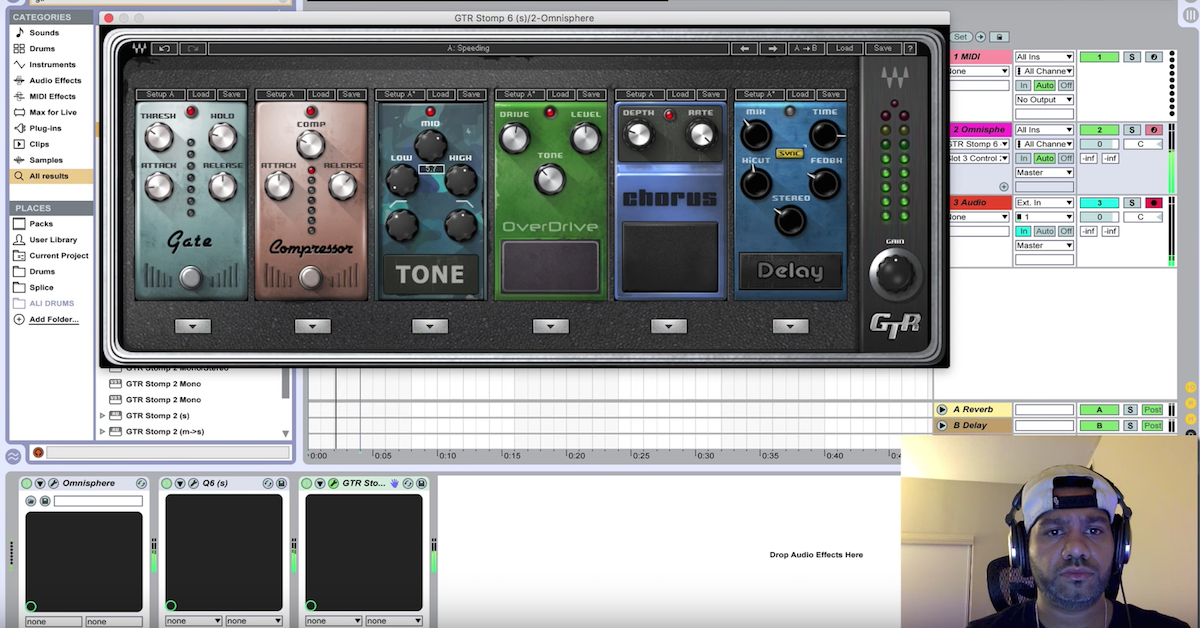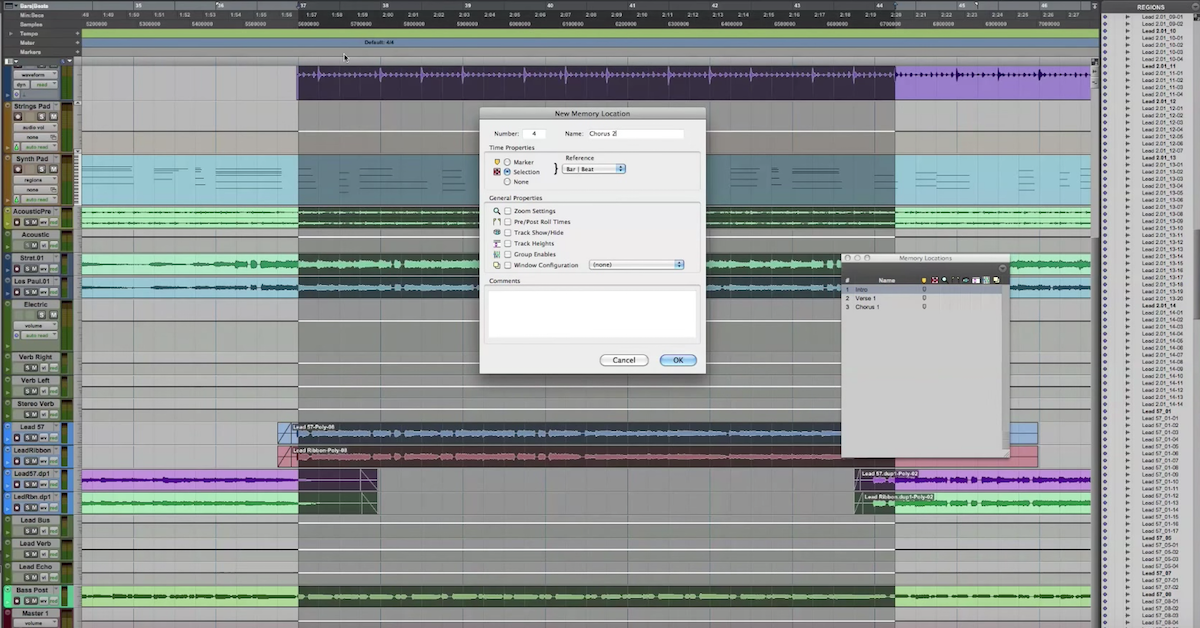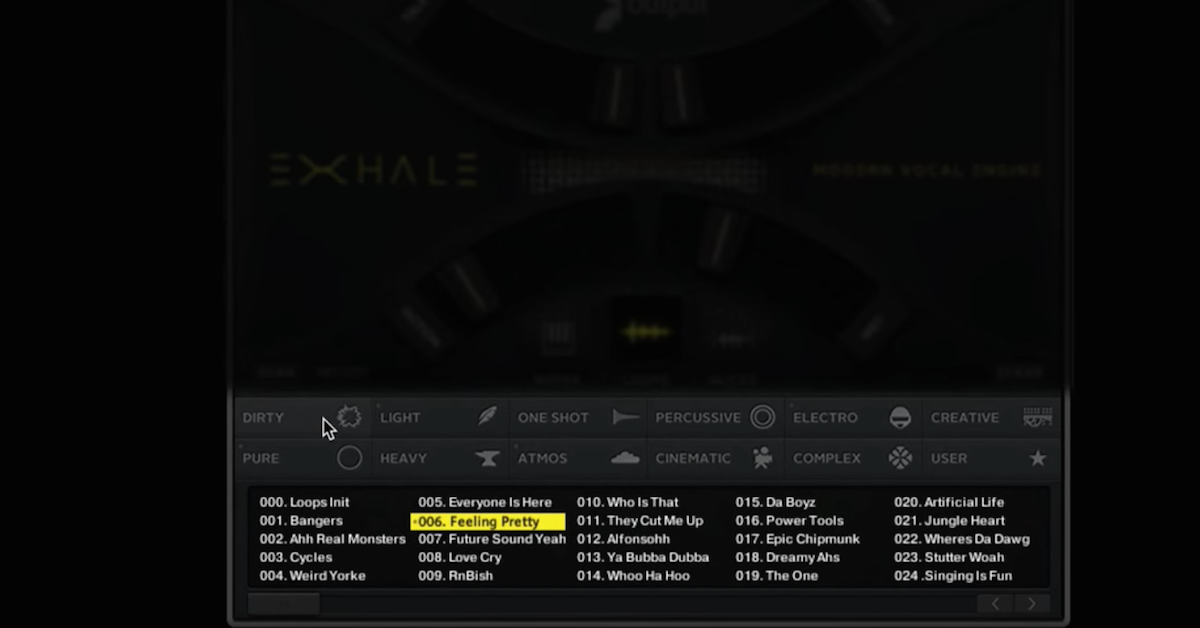16 Considerations for Naming New Instrument Presets
Article Content
It is human nature to categorize the world in order to make sense of things, and to perhaps mitigate the overwhelming variety that exists in all facets of our environment. Anyone that studies a subject in-depth will need to implement (and in some cases invent) logical ways to compartmentalize concepts in order to better understand the ideas, not only in isolation but as they relate to the larger body of knowledge. This process is not an easy one, and there can be pitfalls concerning things that fall into grey areas or potentially unique items that may not fit into any established category.
The process of categorization is not only to understand how or where things fit, but to use the taxonomy as a means of retrieval after the fact. Artists are not immune to the conundrum of categorization. Visual artists work with an astounding array of colors and gradations and often speak about color in terms of general temperature (eg. warm, cold, etc.). While colors have a frequency in terms of light waves, it is musicians and audio engineers that routinely speak in terms of actually specific frequency ranges when discussing sound. In fact, engineers have a whole lexicon to describe sonic issues relating to the spectrum (eg. boxy, harsh, boomy, etc.).
But how and where a sound falls in the range of audible frequencies is only a small part of how that sound can be described (or categorized). The only “pure” sound is the humble sine wave: a periodic and predictable shape that creates no other harmonic or non-harmonic frequencies other than the fundamental frequency. It can be completely described by that frequency, its amplitude, associated envelope and phase.
All other sounds have much more to consider. Is the sound periodic, sustained, transient, etc? Does it sound like something from the physical world or is it electronic-based? Does it evoke a particular emotion? The list goes on. Musical equipment hardware and software developers have been forced to deal with this issue for years. How do you make a sound recognizable with one word or a short phrase? What sort of search tags are fundamental to a sound and easily imagined by a potential user? What are the main categories, subcategories and other relevant descriptors?
I have seen all sorts of solutions. Some are really great and others are pretty much ridiculous. The preset name itself can sometimes say it all. Looking at Logic Pro’s Alchemy, which boasts almost 3500 presets, we see names like “Broken Beat Glitch Loop 01.” I think most musicians would have a general idea of how this sounds. It also implies there is at least one variation called “Broken Beat Glitch Loop 02,” if not more. But other names like “Bad Habit” are far less precise and pretty much meaningless. We might have better luck describing what it is not (e.g. angelic ethereal pad) than imagining what it is. This is where tagging becomes crucial, because it provides several ways to think about and search for a sound so the field of possibilities can be narrowed. In Alchemy, the user can look at the tags of an existing preset as well as edit those tags, create new tags and attach tags to a newly created preset.
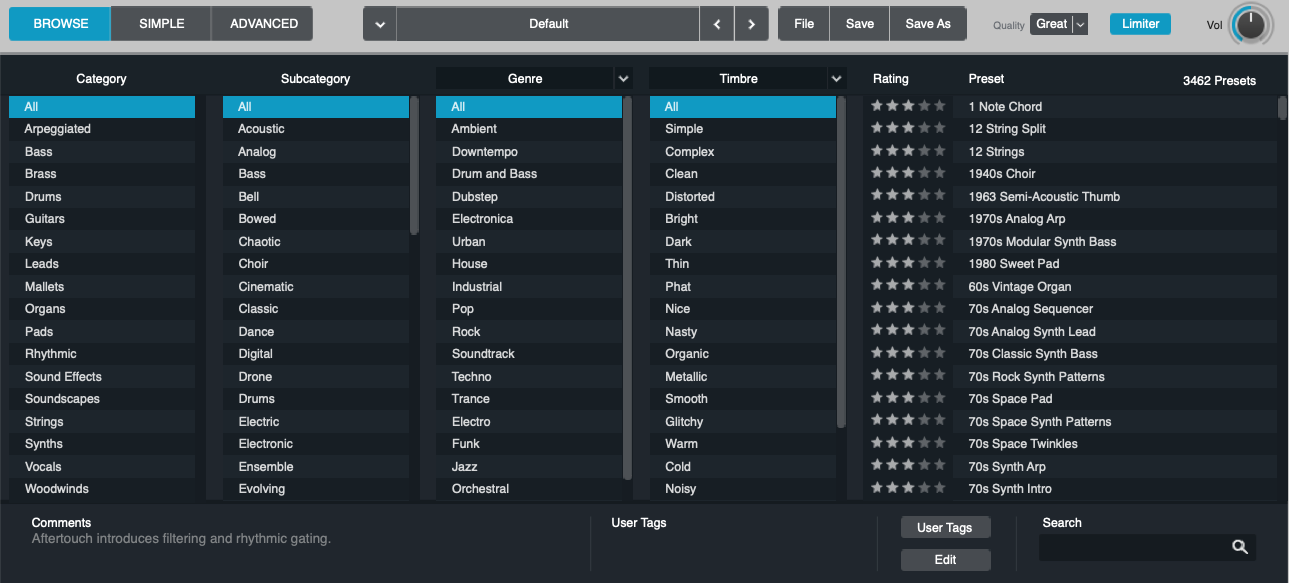
Consider the preset called “Awe Inspiring.” Is it some sort of rising consonant drone that swells to a climax? Is it brassy, string-based or electronic? Does it evolve over several seconds or is it short? Is it cinematic or pop music-based? Maybe some or all of these descriptors are true. Take a look at the tags attached to the sound below:
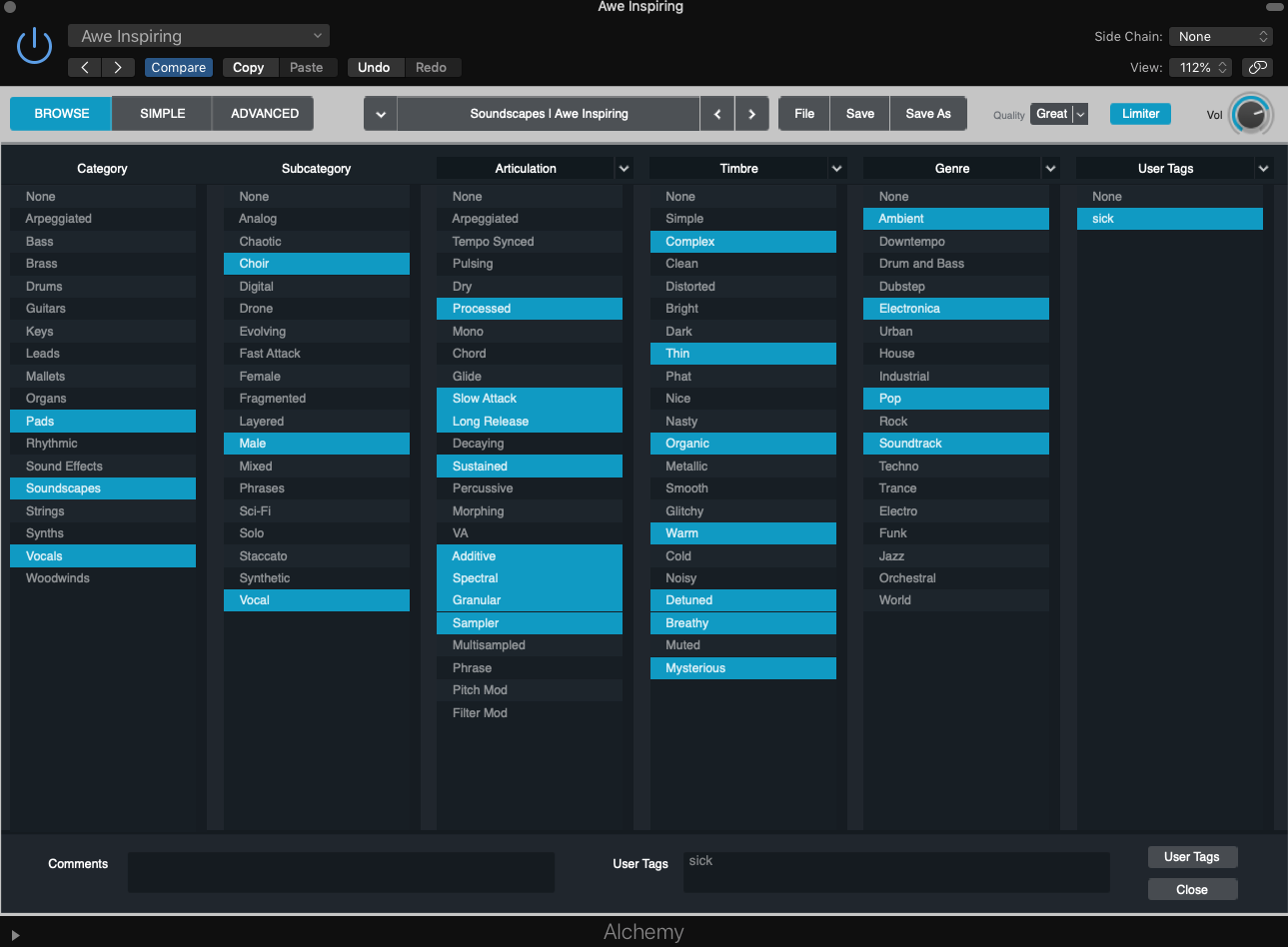
I added “sick” under the User Tag category for demonstration purposes. You can see how this sort of searchable tagging organization can help you quickly zero in on an imagined sound in your head, or help you to describe a sound that you create in a way that will make it retrievable for future projects.
Other instruments such as Spectrasonics Omnisphere also provide this sort of functionality as well. Omnisphere includes a way to add comments that further describe how the patch works, and what sort of controller and modulation programming is baked in.
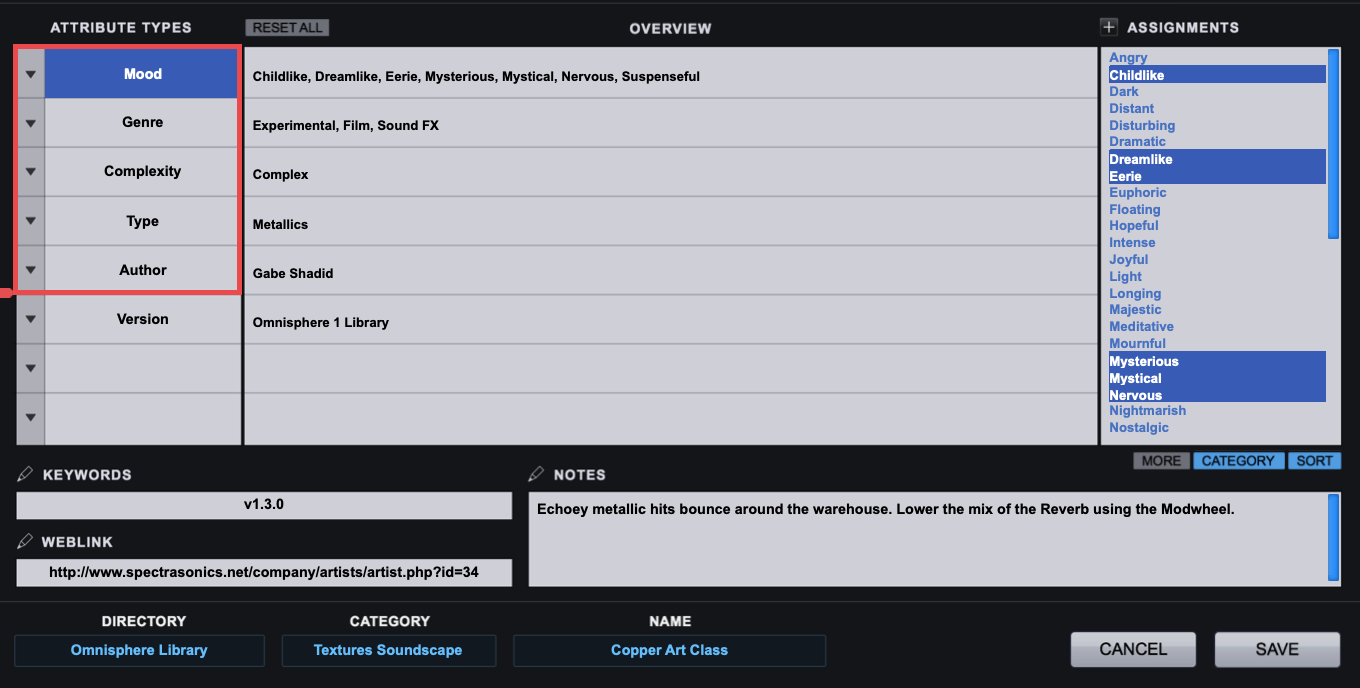
Of course, not all instruments or processing effects allow you to add searchable tags, or even search for existing presets beyond a few general categories. So in this instance, the naming of the preset itself needs to capture the essence of the sound. If you are creating a lot of your own custom sounds, you may need to develop your own lexicon for preset naming or tagging (if possible) that most closely aligns with your workflow. Try to use language that evokes specific sounds in your mind. Idiosyncratic choices may be less valid, however, should you ever decide to share or market these sounds. In ten years you may even forget what the hell you meant by naming that sound “Cat Puke.”
Having looked at hundreds of approaches to this issue over the years it is clear there is no agreed-upon method. At the end of this article, I’ve listed a series of categories I’ve come across, and there is clearly a lot of overlap the more precise you try to get with certain words and phrases fitting in multiple places. I’ve listed a few general ideas below that emerged from this research worth considering.
NOTE 1: The categories below relate mainly to synthesizer/sampler presets and loop naming and tagging. Naming isolated sound effects or sound processing effect presets is a separate although related challenge. Tagging entire songs is even more complex. See the section below: “A Few Words About Metadata and Tagging” regarding this.
NOTE 2: This is by no means an all-inclusive list. Rather, this is merely intended as a starting point to provide some direction in developing your own approach. As mentioned, you will see some terms listed in multiple categories as well.
NOTE 3: Also, the order of categories and subcategories as presented below is somewhat arbitrary, although I’ve tried to start with larger and more inclusive main categories.
Naming and Tagging — Fundamental Considerations
1. Musical Nature or Function
- Lead
- Pad
- Rhythm
- Bass
- Arpeggiated
- Sequence
- Loop
- One-Shots
- Etc.
2. Genre and Subgenre Association
- This list would be enormous and beyond the scope of this article, but you can find an amazing list here if you dare to investigate.
3. Artist-Based: Signature Sounds
- Example: Brian May Lead
4. Song-Based: Iconic Song Association
- Example: Edgar Winter Group – Frankenstein Lead
5. Acoustic Instrument Samples
- Strings
- Brass
- Woodwinds
- Percussion
- Piano and Keyboards
- Guitar
- World Instruments (usually meaning non-Western)
- Other
6. Synthesis Method
- Analog Synth Emulations
- Digital Hardware Emulations
- FM Synthesis
- Subtractive Synthesis
- Additive Synthesis
- Component Modeling Synthesis
- Wavetable Synthesis
- Hybrid
7. Sound Design-Based
- Metallic
- Glassy
- Scrapes
- Noisy
- Chaotic
- Crunchy
- Etc.
8. Envelope or Duration-based
- Transient
- Sustained
- Drones
- Loops
- One-Shots
- Etc.
9. Structure-Based
- Transitions
- Stingers
- Risers
- Drops
- Hits
- Evolving
- Etc.
10. Acoustic Playing Techniques
- Bowed
- Plucked
- Legato
- Staccato
- Muted
- Long
- Short
- Marcato
- Etc.
Note that every acoustic instrument has its own library of articulations and techniques, each of which could be used in tagging or naming.
11. Electronic Playing and Programming Techniques
- Glide
- Filter Sweeps and Other Modulation
- Polyphonic
- Monophonic
- Legato
- Unison
- Detuning
- Layering
- Controller Functionality
- Etc.
12. Sound Processing-Based
- Delay
- Sidechaining
- Saturation
- Chorus
- Flange
- Tremolo
- Etc.
13. Based on a Variation
- Example: “Metallic Hammer Strike 01,” “Metallic Hammer Strike 02,” etc.
(It’s always a good idea to include the zero before single digits in case you have 10 or more variations which cause them to be listed out of order.)
14. Description or Scenario-Based
- Based on the description of a physical movement or act with real or hybrid objects (scraped gong or vibrating spring), or on the description of a sound in a particular place or environment (underwater metal strike).
15. Timbre-Based
- Clean
- Distorted
- Bright
- Dark
- Thin
- Fat
- Glitchy
- Warm
- Cold
- Etc.
16. Emotion or Mood-Based
- Aggressive
- Light
- Ethereal
- Mysterious
- Menacing
- Forlorn
- Etc.
Clearly, it is not possible to use more than a few descriptors in any given preset name. As mentioned above, this is where the power of tagging becomes clear. Hopefully these ideas will help you decide on a useful name or tag the next time you need one.
A Few Words About Metadata and Tagging Music
Metadata is one the main tools used to organize large libraries of music and sound. This helps users quickly find what they are looking for in terms of genre, emotional impact and mood, instrumentation, etc. Music libraries need to find logical and consistent ways to refer to music so their clients can narrow the field quickly with commonly used terms and phrases.
Recently, I came across a company called Tagteam Analysis, which specializes in identifying the most effective metadata for specific music. They use industry standard phraseology and accurate genre and subgenre identification to describe music with meaningful and searchable terms. They use a combination of human analysis and automation in their process. I sent them a few dozen cinematic tracks to see what they would come up with, and a few days later they returned a detailed spreadsheet that included genre, subgenre, tempo, featured instrumentation, an extensive list of moods and styles, a list of sound-alike composers and a concise but surprisingly complete sentence about the musical and emotional nature of each track. It was impressive and definitely worth the $5/track (pricing is based on the number of tracks). In production music libraries, searchability is crucial. Using incorrect or incomplete metadata tags is tantamount to incorrectly shelving a book in a library. Having a second set of ears is always a good idea when it comes to analyzing your own work.
Final Thoughts
If you create your own presets, you need a logical way to name and tag them so you can retrieve and repurpose those sounds in work beyond the current project. You need to strike a balance between what is meaningful to you and standard industry naming practices. You need to identify the essence of a sound so you can relate it to others that are similar. If you are altering existing presets, you need to find ways of describing the new altered sounds that distinguish your preset from the original. None of these tasks are easy or straightforward, but developing consistent and effective naming and tagging strategies that are implemented at the moment of creation will enrich your sonic vocabulary and accelerate your workflow.
Check out my other articles, reviews and interviews
Follow me on Twitter / Instagram / YouTube




